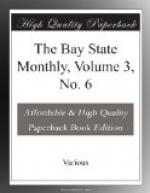THE CONFEDERATE SIDE AT “SHILOH” will be described in this February number in two interesting articles, one by the son of the Confederate leader, General Albert Sidney Johnston, killed at Shiloh, and the other by Colonel Jordan, of general Beauregard’s staff. These, with General Grant’s article, are among the most notable contributions ever made to magazine literature. The illustrations are more than twenty-five in number.
=========================================================
==============
FURTHER PAPERS BY GENERAL GRANT.
In his second paper General Grant will cover an entire year of his service in the war, including the different campaigns against Vicksburg, and its capitulation. In his third paper he will deal with the battle of Chattanooga, including the strategy of the campaign from the time of his assumption of the command. A fourth paper, on the Wilderness campaign, will follow.
While largely engaged with the main features of the campaigns described, General Grant has not failed to take note of significant and characteristic details. These papers will be illustrated with the same regard for thoroughness and accuracy which has characterized the illustrations of the articles in the war series already published.
THE “MONITOR” AND “MERRIMAC,” IN THE MARCH CENTURY.
[Illustration]
The story of this famous fight is described in the March CENTURY by Col. John Taylor Wood, fourth officer of the “Merrimac” in the second day’s fight, and now the senior surviving officer. Col. Wood was afterward commander of the privateer “Tallahassee.” The Federal side of the battle is told by Commander S.D. Greene, U.S.N. (whose death has just occurred), who was the executive officer of the “Monitor,” and operated the guns within the turret. General R.E. Colston, commander of the Confederate forces opposite Newport News, contributes an eyewitness’s account of the same battle, describing, also, the “Merrimac’s” engagement with the Federal fleet before the arrival of the “Monitor.” A paper will soon appear on “THE MONITOR,” BY CAPTAIN JOHN ERICSSON, making record of the circumstances attending the invention of that famous craft, and treating also of the engagement at Hampton Roads. Readers of the articles in the March number will be especially interested in the inventor’s story.
In the April CENTURY will be printed two important papers on THE CAPTURE OF NEW ORLEANS, BY ADMIRAL PORTER AND GEORGE W. CABLE.
Admiral Porter, with whom, as he relates, the expedition against New Orleans originated, and who was in command of the mortar-fleet during the action, describes the Federal side of “The Opening of the Lower Mississippi”; while George W. Cable, the novelist, and at the time a resident of New Orleans, writes of the condition of the city and the circumstances attending its occupation. The illustrations will include a number of battle-scenes from sketches made by Admiral Porter.




